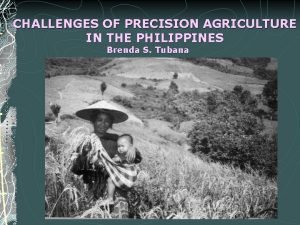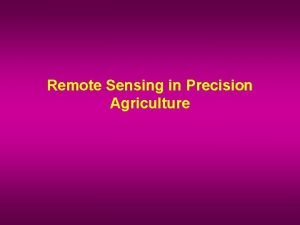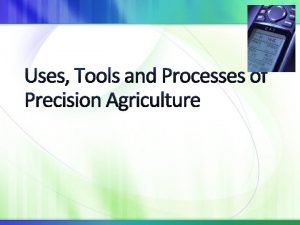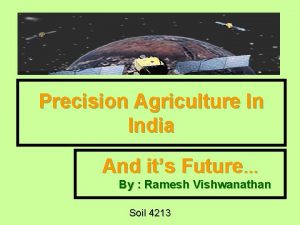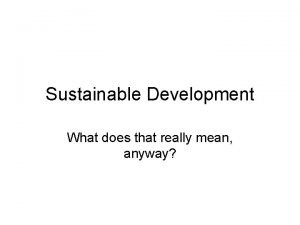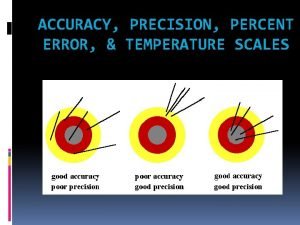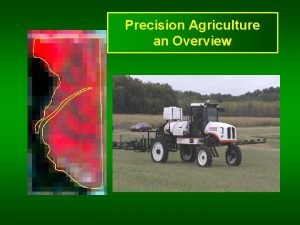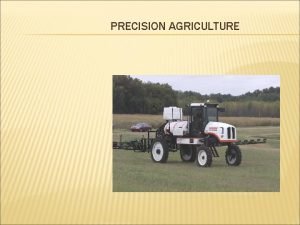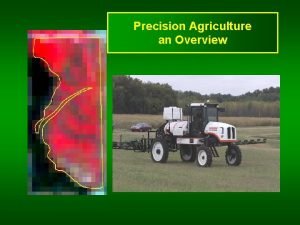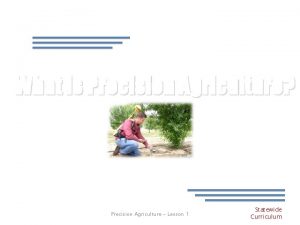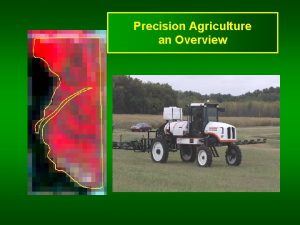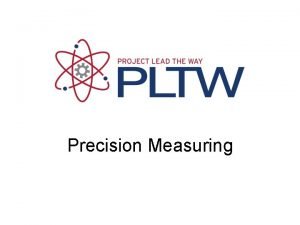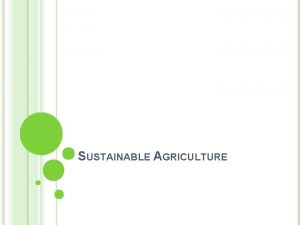Precision Agriculture What does it REALLY mean A
















- Slides: 16

Precision Agriculture What does it REALLY mean? A overview of Precision Agriculture literature

How Old is Precision Agriculture? Precision Agriculture can be considered to be hundreds of years old as any adaption to current farming practices; in order to produce more with less input; would be considered to be “precision” agriculture. Some examples would be: • Native Americans teaching pilgrims how to add organic material to their corn plants • The move from horses to tractors • The introduction of bulk milk tanks versus the can

In the last 20 + years The fundamental concept of precision agriculture, collecting data and making decisions based on that data, has been around for many years in paper form. This was easier to do without technology on small plots. But as the size of farms grew, this no longer was possible. The larger farms require new techniques and tools. 1 (Courtesy of U. S. Department of Agriculture, Agricultural Research Service) • In the 1960 s and 1970 the Geographic Information System (GIS) was one of the first precision farming tools developed however it was used mainly by research institutions. • In late 1980 s the tool to tie all these together was the Global Positioning System (GPS). GPS receivers were used to determine location.

“Now what do we do with it? ” In the infancy of precision farming, early adaptors of precision farming in the late 1980 s and early 1990 s faced many obstacles: lack of understanding, lack of support, equipment that was still in the process of development, and inefficiencies of design. • The first technology used by innovators was yield mapping, which combined GPS and yield monitors. This was followed closely by grid sampling, which used GPS to record soil sample points. We created the technology to create field maps that showed patterns of growth and yield. • Experts said collect 10 years of data and then we will use it – however we didn’t have answers on what to do with it.

What is the definition of Precision Agriculture? Precision agriculture (PA) or satellite farming or site specific crop management (SSCM) is a farming management concept based on observing, measuring and responding to inter and intra-field variability in crops. 2 It has also been described as site specific farming or farming by the foot. Basically they both represent the same thing – the ability to collect data and make decisions in smaller areas than an entire field • In the past farmers collected the data and averaged the entire field (average bushels or product per acre) with the assumption that the entire field had the same value • Currently we have the ability to mark off/identify a small area of a field or a subfield. • The five areas of interest in Precision Agriculture include: subfield, variability, technology, efficiency, benefits

What is a subfield? • A smaller portion of a field (dissect out smaller areas of a field) • Allows for more precise and accurate decision making • Farmers are able to make decisions based on information from that area • Not all decisions are appropriate in other areas

Variability can be found in all fields and can be seen in soil fertility, moisture content, soil texture, topography, plant vigor, and pest populations. Spatial variability is the range of difference or variation in soil composition, crop yield or insect population, and environmental characteristic over distance and depth. Temporal variability is the variation in crop, soil, and environmental characteristic over time. 3 • Spatial variability is the driving force behind Precision Agriculture • Without variability you do not have a reason to subdivide fields. (In the past it was an easier management decisions if you can apply decisions to entire field) • Allows you to implement management practices specific to each subfield • Soil types define much of the variability within a field

Efficiency In the past, it was difficult for farmers to correlate production techniques and crop yields with land variability. This limited their ability to develop the most effective soil/plant treatment strategies that could have enhanced their production. Today, more precise application of pesticides, herbicides, and fertilizers, and better control of the dispersion of those chemicals are possible through precision agriculture, thus reducing expenses, producing a higher yield, and creating a more environmentally friendly farm. 4 • Management Efficiency is the ability of the producer to use Precision Ag Technology for fundamental management of the operation • Decision Making Efficiency is the ability to use financial and production records to make decisions such as: • No till vs. conventional tillage • Which crops give higher return? • The most common case for increased efficiency is variable application of fertilizers/chemicals

Variable Application Farmers identify the variability within each field then use variable applications systems in order to deal with the specific variances within the field. Variable rate application, originally used for fertilizer application on large custom applicators, is now being used in: side dressing fertilizer, foliar application, manure application, and in combination with on-the-go soil monitoring equipment. Possibly the most unique way of using variable rate is with unmanned aerial vehicles (UAV) or drones. These vehicles are useful for in-field use to remotely capture images of plant stress, process images into variable rate application maps, and control by GPS to spray only those areas that need it. 5 Variable rate application – specified amounts of product in certain areas • The goal is to have 100% of the field having the correct amount of product. • Broadcasting the same amount is inefficient

Technology There are many innovative products, tools, and processes that are available to farmers to use in the management of their acres. Those systems include: 5 • Guidance Systems - the cost of the light bar and GPS provides savings from the accurate placement of rows. • Variable Rate by Formula and by Remote-Sensed Data - There are services now available that will determine a variable rate fertilizer application based on remotesensed images that measure moisture and nutrients in the soil. • Data Collection – GPS units are getting smaller, more compact, and more integrated. GPS provides flexibility and ease of use in the collection of spatial data. • Sensor web - As the name implies, it consists of a group of wirelessly connected sensors that form a web throughout an area of interest. The sensors can be programmed to collect humidity, temperature, or other environmental attributes. • Spatial analysis - Software programs provide analysis capabilities for the data that they have collected. Note: Just collecting the data is not sufficient. . Data collection, data analysis, and implementation = Precision agriculture

Benefits Cost savings is the biggest benefit of using precision ag products. Producers believe that the cost of the light bar and GPS provides savings from the accurate placement of rows. Comments from producers indicate that the savings in chemicals and seed has meant a one-year to two-year payback. 5 Environmental Benefits – ability to reduce or strategically place inputs or make decisions that will reduce impact on natural resources • Terraces, buffer strips, products at lower rate • Economic Benefits – decisions that result in higher monetary return • Lower operating cost = more income

Tools of Precision Agriculture A wrench is a tool and does not generate cash flow by itself. The value of precision agriculture tools is determined by how they are used. . .

What are the tools of Precision Agriculture? Global Positioning System. . . GPS • GPS can now be connected to handheld computers through compact flash ports, secure digital ports, or even wirelessly. Tablet computers, hardened covers, or handheld computer devices come with data collection software. Wireless connections to the Internet in the field allow real-time download of aerial images or other data. This all increases the ease of use and robustness desired by the early majority. • • Geographic Information Systems. . . GIS Intelligent Devices and Implements. . . IDI Remote Sensing Computers

What is your DEFINTION of Precision Agriculture? • Include • • • Subfield area Variability Efficiency Technology Benefits • Assignment: Write your own definition of Precision Agriculture

Resources 1. History of Precision Ag http: //www. delmarlearning. com/companions/content/140188105 X/tren ds/history_pre_agr. asp 2. Excerpts were taken from Wikipedia http: //psstldemo 3. esri. com/apps/storytelling_Ag. Five/ Text is available under the Creative Commons Attribution-Share. Alike License 3. Agricultural Primer, The Precision-Farming guide for Agriculturists, Deere & Company 4. GPS. gov 5. New Technologies, Tools, and Techniques http: //www. delmarlearning. com/companions/content/140188105 X/tren ds/new_tech. asp http: //www. gps. gov/applications/agriculture/ This presentation was compiled by: Southeast Community College, Agriculture Business and Technology Department, Beatrice , NE.

Brought to you by: This work for Mapping New Careers in Geospatial Technologies Project by Southeast Community College is licensed under a Creative Commons Attribution 4. 0 International License. This workforce solution was funded by a grant awarded by the U. S. Department of Labor’s Employment and Training Administration. The solution was created by the grantee and does not necessarily reflect the official position of the U. S. Department of Labor. The Department of Labor makes no guarantees, warranties, or assurances of any kind, express or implied, with respect to such information, including any information on linked sites and including, but not limited to, accuracy of the information or its completeness, timeliness, usefulness, adequacy, continued availability, or ownership.
 Precision and non precision instruments
Precision and non precision instruments Semi precision attachment
Semi precision attachment Bcd gösterimi
Bcd gösterimi Precision agriculture in the philippines
Precision agriculture in the philippines Remote sensing in precision agriculture
Remote sensing in precision agriculture Define precision farming
Define precision farming Precision agriculture in india
Precision agriculture in india What british people really mean
What british people really mean Sustainable living meaning
Sustainable living meaning Does a string and cup really work
Does a string and cup really work Discounted cumulative gain
Discounted cumulative gain Absolute mean deviation calculator
Absolute mean deviation calculator What does mean mean
What does mean mean Mean matter
Mean matter C to k formula
C to k formula How does agriculture create ripples in the world
How does agriculture create ripples in the world Dear mum i feel really unhappy i wish
Dear mum i feel really unhappy i wish



